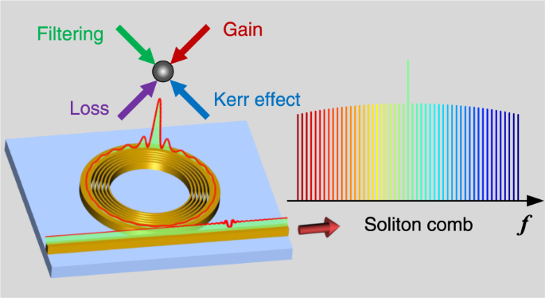Dispersion-less Kerr solitons in spectrally confined optical cavities

In a new paper published in (Nature) Light Science & Application (9 Jan 2023), a team of scientists, led by Professor Xiaoxiao Xue from Tsinghua University and Professor Philippe Grelu from Université de Bourgogne and laboratory ICB demonstrated a novel type of cavity solitons, which they named “dispersion-less” solitons.
Distinct from the solitons previously known, dispersion-less solitons exist when the chromatic dispersion becomes negligible. The formation of dispersion-less solitons relies on a composite balance involving spectral filtering, self-phase modulation, parametric gain, and cavity loss. When the filter order tends to infinity, the soliton evolves asymptotically toward a transform-limited Nyquist-like pulse, uncovering an unexpected link between conservative and dissipative solitons. The Nyquist soliton features a fully confined ultra-flat spectrum, and the pulse energy can be promoted indefinitely without altering its temporal and spectral shapes.
Dispersion-less solitons were investigated in a coherently driven fiber ring cavity with programmable dispersion and loss. Dispersion-less soliton molecules and their deterministic transitioning to single solitons were also evidenced. A theoretical model was developed showing excellent agreement with the experimental observation. The scientists summarize their finding:

- Download the article
- Open access article:
Xue, X., Grelu, P., Yang, B. et al. Dispersion-less Kerr solitons in spectrally confined optical cavities. Light Sci Appl 12, 19 (2023). https://doi.org/10.1038/s41377-022-01052-8 - Contact:
Professeur Philippe Grelu, philippe.grelu@u-bourgogne.fr
These new dispersion-less solitons are tailored by spectral filtering, which is precisely controlled in the experiment. In the limit when the filter becomes rectangular, spectral filtering and Kerr nonlinearity can perfectly balance each other, which is astonishing. Indeed, the dispersion-less soliton then becomes a Nyquist soliton, a waveform that is prototypical in the optimization of optical communications because it has an optimal compact spectral extension.
The Nyquist soliton is fascinating for its fully confined ultra-flat spectrum and immunity to energy-width scaling limitations. In our experiments, about 99.6% of the total spectral power is confined within -6 dB from the soliton central wavelength intensity. This is very attractive for highly efficient flat Kerr frequency comb generation, which is a recurrent challenging objective.” they added.
Although our experiments are performed with macroscopic fiber cavities, the concept can be readily transported to integrated platforms. By employing photonic crystal structures to tailor the spectral loss and dispersion, it is possible to generate ultra-flat microcombs for a wide range of applications such as communications, lidar ranging, optical computing, etc.” the scientists forecast.
- kc_data:
- a:8:{i:0;s:0:"";s:4:"mode";s:2:"kc";s:3:"css";s:0:"";s:9:"max_width";s:0:"";s:7:"classes";s:0:"";s:9:"thumbnail";s:0:"";s:9:"collapsed";s:0:"";s:9:"optimized";s:0:"";}
- kc_raw_content:
- [kc_row use_container="yes" _id="720302"][kc_column width="12/12" video_mute="no" _id="970983"][kc_column_text _id="984949"]
In a new paper published in (Nature) Light Science & Application (9 Jan 2023), a team of scientists, led by Professor Xiaoxiao Xue from Tsinghua University and Professor Philippe Grelu from Université de Bourgogne and laboratory ICB demonstrated a novel type of cavity solitons, which they named “dispersion-less” solitons.
Distinct from the solitons previously known, dispersion-less solitons exist when the chromatic dispersion becomes negligible. The formation of dispersion-less solitons relies on a composite balance involving spectral filtering, self-phase modulation, parametric gain, and cavity loss. When the filter order tends to infinity, the soliton evolves asymptotically toward a transform-limited Nyquist-like pulse, uncovering an unexpected link between conservative and dissipative solitons. The Nyquist soliton features a fully confined ultra-flat spectrum, and the pulse energy can be promoted indefinitely without altering its temporal and spectral shapes.
Dispersion-less solitons were investigated in a coherently driven fiber ring cavity with programmable dispersion and loss. Dispersion-less soliton molecules and their deterministic transitioning to single solitons were also evidenced. A theoretical model was developed showing excellent agreement with the experimental observation. The scientists summarize their finding:
[/kc_column_text][kc_spacing height="30px" _id="723077"][/kc_column][/kc_row][kc_row use_container="yes" _id="374546"][kc_column width="45%" _id="553558"][kc_spacing height="20" _id="636370"][kc_single_image image_size="full" _id="12806" image_source="media_library" image="39936"][kc_spacing height="20" _id="721759"][kc_column_text _id="137197"]- Download the article
- Open access article:
Xue, X., Grelu, P., Yang, B. et al. Dispersion-less Kerr solitons in spectrally confined optical cavities. Light Sci Appl 12, 19 (2023). https://doi.org/10.1038/s41377-022-01052-8 - Contact:
Professeur Philippe Grelu, philippe.grelu@u-bourgogne.fr
[/kc_column_text][/kc_column][/kc_row]These new dispersion-less solitons are tailored by spectral filtering, which is precisely controlled in the experiment. In the limit when the filter becomes rectangular, spectral filtering and Kerr nonlinearity can perfectly balance each other, which is astonishing. Indeed, the dispersion-less soliton then becomes a Nyquist soliton, a waveform that is prototypical in the optimization of optical communications because it has an optimal compact spectral extension.
The Nyquist soliton is fascinating for its fully confined ultra-flat spectrum and immunity to energy-width scaling limitations. In our experiments, about 99.6% of the total spectral power is confined within -6 dB from the soliton central wavelength intensity. This is very attractive for highly efficient flat Kerr frequency comb generation, which is a recurrent challenging objective.” they added.
Although our experiments are performed with macroscopic fiber cavities, the concept can be readily transported to integrated platforms. By employing photonic crystal structures to tailor the spectral loss and dispersion, it is possible to generate ultra-flat microcombs for a wide range of applications such as communications, lidar ranging, optical computing, etc.” the scientists forecast.
